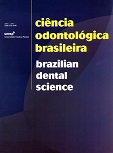Atividade de cárie na primeira infância fatalidade ou transmissibilidade?
DOI:
https://doi.org/10.14295/bds.2004.v7i4.216Abstract
A lesão de cárie em dentes decíduos é encarada com normalidade e considerada uma fatalidade,pois muitas mães desconhecem que esta alteração constitui uma doença infecciosa transmissível, passível de prevenção e que pode ser controlada evitando a contaminação entre as mães e seus filhos. Esta pesquisa teve como objetivo avaliar a correlação entre a atividade de cárie entre crianças e suas mães, bem como analisar sua relação com o nível de Streptococcus do grupo mutans. Foi avaliada a atividade de cárie de 51 crianças de 2 meses a 5 anos de idade, assim como a de suas mães. O biofilme bacteriano foi coletado dos dentes das crianças, para realizar a contagem de colônias do microrganismo. Pode-se observar que não houve evidência de que o nível de Streptococcus do grupo mutans presente na cavidade bucal das crianças dependeu de suas idades, e que não ocorreu associação entre atividade de cárie e o aumento do nível deste microrganismo.Os autores encontraram também evidência de associação entre a atividade de cárie das crianças e de suas mães. Desta forma concordamos que há necessidade do desenvolvimento de programas educativos voltados para os pais e preventivos voltados para os bebês procurando estabelecer hábitos saudáveis para evitar a contaminação da cavidade bucal da criança e oferecer a verdadeira promoção de saúde.Downloads
Downloads
Published
How to Cite
Issue
Section
License
Brazilian Dental Science uses the Creative Commons (CC-BY 4.0) license, thus preserving the integrity of articles in an open access environment. The journal allows the author to retain publishing rights without restrictions.
=================




























